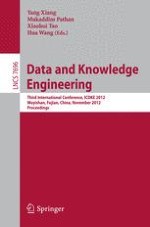2012 | Buch
Data and Knowledge Engineering
Third International Conference, ICDKE 2012, Wuyishan, Fujian, China, November 21-23, 2012. Proceedings
herausgegeben von: Yang Xiang, Mukaddim Pathan, Xiaohui Tao, Hua Wang
Verlag: Springer Berlin Heidelberg
Buchreihe : Lecture Notes in Computer Science
